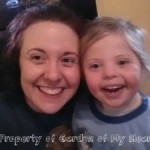Hear that? It’s the sound of my balloon bursting.
Until now, we have had an amicable relationship with our school district. We felt very in sync with their suggestions for Rowenna, and we loved her placements for the last two years.
We know many children who have various diagnoses, and many of them did an extra year of preschool before entering kindergarten at age 6. The law in my state also allows for children to begin school at age 6.
So it never crossed my mind to ask our district if Rowenna would be forced into kindergarten simply because she is turning 5. And it definitely never crossed my mind that the district would try to tell me it’s “illegal” to have her do an additional year of 4K to work on more foundational skills before kindergarten.
I mean, here I was, wrongly assuming placement would be based on need and best fit – not the district’s cookie cutter policy that they are trying to pass off as state and federal law. I was wrongly assuming that I could hold the district to their word when they said decisions would be made as a team, with hubby and I as the head of that team.
I hadn’t originally planned to blog about this year’s IEP process because we were expecting it to be wonderfully mundane, a formality. Unfortunately, instead of a one-off post about the end result of the process, I will be blogging as we go along in order to share the full picture.
This morning, I met with the elementary special education placement coordinator for our district. She and I had previously had a rather awful conversation about Rowenna’s placement for next year. Citing that Rowenna “won’t be reading” by the end of next school year, she would be placed in a special education program reserved for students who require a high degree of support.
Read: self contained classroom from which Rowenna would have to “earn” her escape.
So here’s where I pause briefly to make this disclaimer: I have no issue with a self contained classroom if it is truly the best method for educating a student. What’s right for my child might not be right for yours and I completely support your decision, even if it looks different than mine.
However, it’s not what Rowenna needs right now. While she has difficulty initiating play, she thrives on observing and then doing. She needs peer models to do this.
I toured a regular education classroom at our home school while the district representative pointed out all the ways the room would be challenging for Rowenna. (There are so many kids! They know all the days of the week! They are singing!) All I saw was a thriving room full of little bodies doing hard work, a place where Rowenna might succeed with the right kind of supports. A place where she should have the chance to try.
We followed that with a lengthy discussion wherein it became incredibly apparent that the district doesn’t intend to support Rowenna at all. Under the guise of innocent sounding phrases like “individualized instruction” and “what’s best for Rowenna,” she painted a picture of a program where Rowenna spends the day with special education students while being “allowed” to leave that room for things like lunch or music.
Here’s the thing: there is no “allowing” in public schools for regular education students. Can you imagine? Can you imagine what would happen if a teacher said to a parent how lucky their child is to be allowed to remain with her class the entire day?
The standards set forth for students receiving special education services are enormous and unjust. My daughter is expected to show perfect behavior, perfect patience, and perfect mastery. Mistakes are counted against her as signs she needs more special education. Weaknesses are used as signs that she shouldn’t be with her peers. She is being denied a chance at kindergarten due to the potential that she may not be reading by the end of the year, even though regular education students are not denied education based on such potential.
We then went to tour the proposed placement. It’s a tiny room, tucked back into a corner of the school. The class has children from kindergarten to third grade and just one special education teacher. This teacher is expected to modify curriculum for 15 students across 4 grades, using some of the most in depth IEPs in the district. There are 4 paraprofessionals in the class as well, but they are not always present as some accompany the handful of students who do spend a few hours outside this classroom.
I wanted to throw up. This is the best they can do? This is “what’s best” for Rowenna?
What do they think of my child if they think my vibrant, sunshine girl will thrive in segregation?
The district representative scrambled to explain and justify while the staff I spoke with confirmed my worst nightmares, the things the representative said just weren’t true about the program. Rowenna would spend her time in this room and not with her peers. “Pull outs” to a regular education room would be brief, if they happened at all. Recess is segregated. Lunch is segregated unless Rowenna can prove she can “handle” lunch with her peers. The teacher was checked out and looked exhausted. (And I say that with nothing but love and understanding – teaching is a tough gig sometimes, and they gave this class to a brand new teacher. Completely inappropriate, and yet another sign that the district is simply warehousing these kids out of the way. There’s nothing wrong with being a first year teacher, but this set up requires a bit of experience, in my opinion.) There is no way for her to get out of this situation unless Rowenna can prove she is entirely “at pace” with her peers, a standard only held to special education students.
All this under the pretty trappings of “specialized instruction.”
If a school can’t get recess inclusion right, I can’t hold out much hope that they will get anything else right.
Again, to be clear, I have nothing against special education. In fact, I think Rowenna needs it, and that she likely needs more than even her peers with Down syndrome. But special education doesn’t need to be an address, a place for her to park every day. It needs to be a service and a way to help her navigate the world. That cannot be done while stuck inside a room without her peers.
So this is our square one. I have a lot of research and soul searching to do before we officially meet with the IEP team. And while the district representative insisted on saying the IEP team will decide the future, I have every intention of reminding them that hubby and I, and ultimately Rowenna, lead this team and make the final decisions.
I have Rowenna’s future, well being, and happiness to advocate for, and I refuse to let her down.








8 Responses to Pop